IIR数字滤波器的设计外文文献以及翻译
IIR数字滤波器的设计外文文献以与翻译
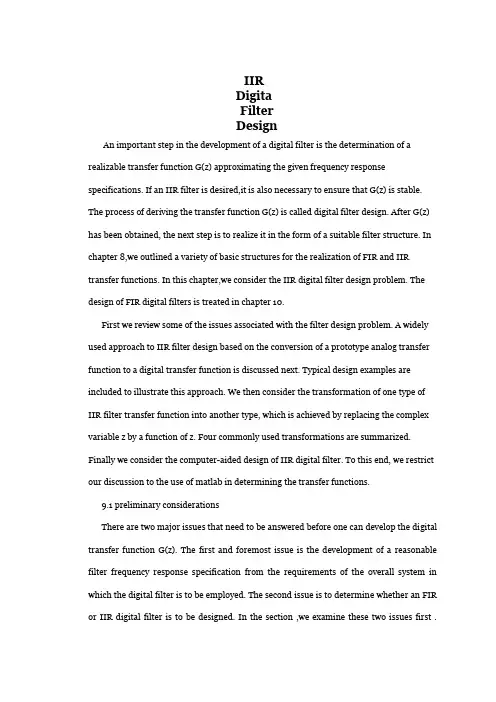
IIRDigitaFilterDesignAn important step in the development of a digital filter is the determination of a realizable transfer function G(z) approximating the given frequency response specifications. If an IIR filter is desired,it is also necessary to ensure that G(z) is stable. The process of deriving the transfer function G(z) is called digital filter design. After G(z) has been obtained, the next step is to realize it in the form of a suitable filter structure. In chapter 8,we outlined a variety of basic structures for the realization of FIR and IIR transfer functions. In this chapter,we consider the IIR digital filter design problem. The design of FIR digital filters is treated in chapter 10.First we review some of the issues associated with the filter design problem. A widely used approach to IIR filter design based on the conversion of a prototype analog transfer function to a digital transfer function is discussed next. Typical design examples are included to illustrate this approach. We then consider the transformation of one type of IIR filter transfer function into another type, which is achieved by replacing the complex variable z by a function of z. Four commonly used transformations are summarized. Finally we consider the computer-aided design of IIR digital filter. To this end, we restrict our discussion to the use of matlab in determining the transfer functions.9.1 preliminary considerationsThere are two major issues that need to be answered before one can develop the digital transfer function G(z). The first and foremost issue is the development of a reasonable filter frequency response specification from the requirements of the overall system in which the digital filter is to be employed. The second issue is to determine whether an FIR or IIR digital filter is to be designed. In the section ,we examine these two issues first .Next we review the basic analytical approach to the design of IIR digital filters and then consider the determination of the filter order that meets the prescribed specifications. We also discuss appropriate scaling of the transfer function.9.1.1 Digital Filter SpecificationsAs in the case of the analog filter,either the magnitude and/or the phase(delay) response is specified for the design of a digital filter for most applications. In some situations, the unit sample response or step response may be specified. In most practical applications, the problem of interest is the development of a realizable approximation to a given magnitude response specification. As indicated in section 4.6.3, the phase response of the designed filter can be corrected by cascading it with an allpass section. The design of allpass phase equalizers has received a fair amount of attention in the last few years. We restrict our attention in this chapter to the magnitude approximation problem only. We pointed out in section 4.4.1 that there are four basic types of filters,whose magnitude responses are shown in Figure 4.10. Since the impulse response corresponding to each of these is noncausal and of infinite length, these ideal filters are not realizable. One way of developing a realizable approximation to these filter would be to truncate the impulse response as indicated in Eq.(4.72) for a lowpass filter. The magnitude response of the FIR lowpass filter obtained by truncating the impulse response of the ideal lowpass filter does not have a sharp transition from passband to stopband but, rather, exhibits a gradual "roll-off."Thus, as in the case of the analog filter design problem outlined in section 5.4.1, the magnitude response specifications of a digital filter in the passband and in the stopband are given with some acceptable tolerances. In addition, a transition band is specified between the passband and the stopband to permit the magnitude to drop off smoothly. For example, the magnitude )(j e G of a lowpass filter may be given as shown in Figure7.1. As indicated in the figure, in the passband defined by 0p ωω≤≤, we require that the magnitude approximates unity with an error of p δ±,i.e.,p p j p for e G ωωδδω≤+≤≤-,1)(1.In the stopband, defined by πωω≤≤s ,we require that the magnitude approximates zero with an error of i s ,δ.e.,,)(s j e G δω≤ forπωω≤≤s . The frequencies p ω and s ω are , respectively, called the passband edge frequency and the stopband edge frequency. The limits of the tolerances in the passband and stopband, p δ and s δ, are usually called the peak ripple values. Note that the frequency response )(ωj e G of a digital filter is a periodic function of ω,and the magnitude response of a real-coefficient digital filter is an even function ofω. As a result, the digital filter specifications are given only for the range πω≤≤0.Digital filter specifications are often given in terms of the loss function,)(log 20)(10ωωζj e G -=, in dB. Here the peak passband ripplep α and the minimum stopband attenuations α are given in dB,i.e., the loss specifications of a digitalfilter are given bydB p p )1(log 2010δα--=,dB s s )(log 2010δα-=.9.1 Preliminary ConsiderationsAs in the case of an analog lowpass filter, the specifications for a digital lowpass filter may alternatively be given in terms of its magnitude response, as in Figure 7.2. Here the maximum value of the magnitude in the passband is assumed to be unity, and themaximum passband deviation, denoted as 1/21ε+,is given by the minimum value of the magnitude in the passband. The maximum stopband magnitude is denoted by 1/A.For the normalized specification, the maximum value of the gain function or the minimum value of the loss function is therefore 0 dB. The quantity max α given bydB )1(log 20210max εα+=Is called the maximum passband attenuation. Forp δ<<1, as is typically the case, itcan be shown thatp p αδα2)21(log 2010max ≅--≅ The passband and stopband edge frequencies, in most applications, are specified in Hz, along with the sampling rate of the digital filter. Since all filter design techniques are developed in terms of normalized angular frequencies p ω and s ω,the sepcified critical frequencies need to be normalized before a specific filter design algorithm can be applied. Let T F denote the sampling frequency in Hz, and F P and F s denote, respectively,the passband and stopband edge frequencies in Hz. Then the normalized angular edge frequencies in radians are given byT F F F F p TpT p p ππω22==Ω= T F F F F s T s T s s ππω22==Ω= 9.1.2 Selection of the Filter TypeThe second issue of interest is the selection of the digital filter type,i.e.,whether an IIR or an FIR digital filter is to be employed. The objective of digital filter design is to develop a causal transfer function H(z) meeting the frequency response specifications. For IIR digital filter design, the IIR transfer function is a real rational function of 1-z . H(z)=N MdNzz d z d d pMz z p z p p ------++++++++ (2211022110)Moreover, H(z) must be a stable transfer function, and for reduced computational complexity, it must be of lowest order N. On the other hand, for FIR filter design, the FIR transfer function is a polynomial in 1-z:∑=-=Nnnz nhzH] [)(For reduced computational complexity, the degree N of H(z) must be as small as possible.In addition, if a linear phase is desired, then the FIR filter coefficients must satisfy the constraint:][][Nnhnh-±=T here are several advantages in using an FIR filter, since it can be designed with exact linear phase and the filter structure is always stable with quantized filter coefficients. However, in most cases, the order N FIR of an FIR filter is considerably higher than the order N IIR of an equivalent IIR filter meeting the same magnitude specifications. In general, the implementation of the FIR filter requires approximately N FIR multiplications per output sample, whereas the IIR filter requires 2N IIR+1 multiplications per output sample. In the former case, if the FIR filter is designed with a linear phase, then the number of multiplications per output sample reduces to approximately (N FIR+1)/2. Likewise, most IIR filter designs result in transfer functions with zeros on the unit circle,and the cascade realization of an IIR filter of orderIIRN with all of the zeros on the unitcircle requires [(3IIRN+3)/2] multiplications per output sample. It has been shown that for most practical filter specifications, the ratio N FIR/N IIR is typically of the order of tens or more and, as a result, the IIR filter usually is computationally more efficient[Rab75]. However ,if the group delay of the IIR filter is equalized by cascading it with an allpass equalizer, then the savings in computation may no longer be that significant [Rab75]. In many applications, the linearity of the phase response of the digital filter is not an issue,making the IIR filter preferable because of the lower computational requirements.9.1.3 Basic Approaches to Digital Filter DesignIn the case of IIR filter design, the most common practice is to convert the digital filter specifications into analog lowpass prototype filter specifications, and then to transform it into the desired digital filter transfer function G(z). This approach has been widely used for many reasons:(a) Analog approximation techniques are highly advanced.(b) They usually yield closed-form solutions.(c) Extensive tables are available for analog filter design.(d) Many applications require the digital simulation of analog filters.In the sequel, we denote an analog transfer function as)()()(s D s P s H a a a =, Where the subscript "a" specifically indicates the analog domain. The digital transfer function derived form H a (s) is denoted by)()()(z D z P z G = The basic idea behind the conversion of an analog prototype transfer function H a (s) into a digital IIR transfer function G(z) is to apply a mapping from the s-domain to the z-domain so that the essential properties of the analog frequency response are preserved. The implies that the mapping function should be such that(a) The imaginary(j Ω) axis in the s-plane be mapped onto the circle of the z-plane.(b) A stable analog transfer function be transformed into a stable digital transfer function.To this end,the most widely used transformation is the bilinear transformation described in Section 9.2.Unlike IIR digital filter design,the FIR filter design does not have any connection with the design of analog filters. The design of FIR filter design does not have anyconnection with the design of analog filters. The design of FIR filters is therefore based on a direct approximation of the specified magnitude response,with the often added requirement that the phase response be linear. As pointed out in Eq.(7.10), a causal FIR transfer function H(z) of length N+1 is a polynomial in z -1 of degree N. The corresponding frequency response is given by∑=-=N n n j j en h e H 0][)(ωω.It has been shown in Section 3.2.1 that any finite duration sequence x[n] of length N+1 is completely characterized by N+1 samples of its discrete-time Fourier transfer X(ωj e ). As a result, the design of an FIR filter of length N+1 may be accomplished by finding either the impulse response sequence {h[n]} or N+1 samples of its frequency response )H(e j ω. Also, to ensure a linear-phase design, the condition of Eq.(7.11) must be satisfied. Two direct approaches to the design of FIR filters are the windowed Fourier series approach and the frequency sampling approach. We describe the former approach in Section 7.6. The second approach is treated in Problem 7.6. In Section 7.7 we outline computer-based digital filter design methods.作者:Sanjit K.Mitra国籍:USA出处:Digital Signal Processing -A Computer-Based Approach 3eIIR数字滤波器的设计在一个数字滤波器发展的重要步骤是可实现的传递函数G(z)的接近给定的频率响应规格。
【最新推荐】基于DSP的IIR滤波器设计外文文献
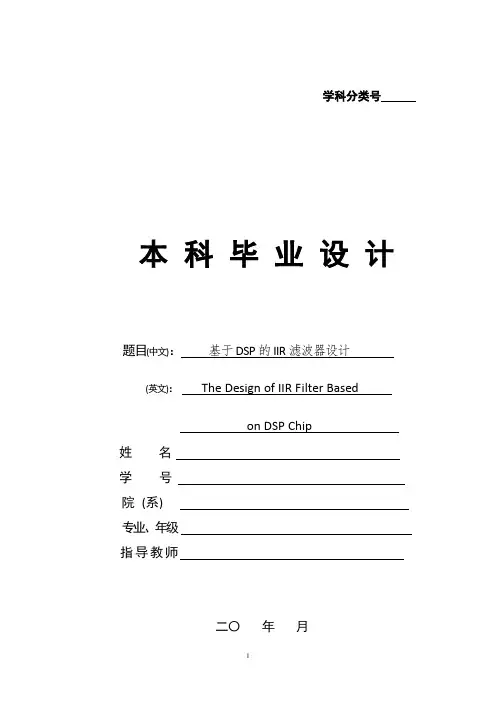
学科分类号本科毕业设计题目(中文):基于DSP的IIR滤波器设计(英文):The Design of IIR Filter Basedon DSP Chip姓名学号院(系)专业、年级指导教师二〇年月目录摘要 (1)Abstract. (2)1 绪论 (2)1.1 认识数字信号处理和IIR数字滤波器 (3)1.2 数字滤波器的实现方法 (4)1.3 主要研究内容 (6)2 滤波器原理基础 (6)2.1 IIR数字滤波器的优缺点 (7)2.2 IIR数字滤波器的设计方法和原理 (9)2.2.1 脉冲响应不变法 (12)2.2.2 双线性变换法 (14)2.3 IIR滤波器的基本结构 (17)3 IIR滤波器的设计过程及DSP的实现 (21)3.1 IIR滤波器的设计过程 (21)3.2 DSP系统的设计流程 (22)3.3 IIR数字滤波器在DSP上的实现 (22)参考文献 (27)附录 (28)致谢 (31)外文文献译文......................................................................................... 1-3 外文文献原文基于DSP的IIR滤波器设计摘要:数字信号处理(Digital Signal Processing,DSP)是一门涉及许多学科而又广泛应用于众多领域的新兴学科。
早在20世纪60年代,数字信号处理(即信号的数字化及数字处理)理论已经被被提出,到20世纪70年代,DSP理论和算法基础才被人提出。
不久之后,1982年世界上第一枚DSP芯片诞生了。
这枚DSP芯片在当时运算速度很快,尤其是在编码解码和语音合成方面得到广泛应用。
随着科学技术的飞速发展,数字化硬件技术得到长足的发展,这就带动了数字信号处理的飞速发展,也使得它得到了很多的实际应用,由此奠定了DSP这一词的地位。
之后,DSP芯片的科研不断推陈出新,每一代的DSP芯片都向着使运算速度更快、精度更高的目标发展,应用于通信、语音、医疗、仪器仪表和家用电器等人类生产生活的各个领域。
matlab iir低通滤波器设计
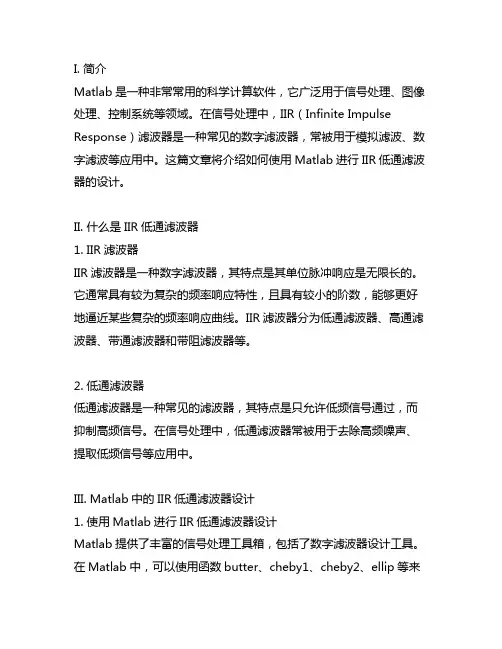
I. 简介Matlab是一种非常常用的科学计算软件,它广泛用于信号处理、图像处理、控制系统等领域。
在信号处理中,IIR(Infinite Impulse Response)滤波器是一种常见的数字滤波器,常被用于模拟滤波、数字滤波等应用中。
这篇文章将介绍如何使用Matlab进行IIR低通滤波器的设计。
II. 什么是IIR低通滤波器1. IIR滤波器IIR滤波器是一种数字滤波器,其特点是其单位脉冲响应是无限长的。
它通常具有较为复杂的频率响应特性,且具有较小的阶数,能够更好地逼近某些复杂的频率响应曲线。
IIR滤波器分为低通滤波器、高通滤波器、带通滤波器和带阻滤波器等。
2. 低通滤波器低通滤波器是一种常见的滤波器,其特点是只允许低频信号通过,而抑制高频信号。
在信号处理中,低通滤波器常被用于去除高频噪声、提取低频信号等应用中。
III. Matlab中的IIR低通滤波器设计1. 使用Matlab进行IIR低通滤波器设计Matlab提供了丰富的信号处理工具箱,包括了数字滤波器设计工具。
在Matlab中,可以使用函数butter、cheby1、cheby2、ellip等来设计IIR低通滤波器。
2. 设计步骤设计IIR低通滤波器的一般步骤如下:a. 确定通带和阻带的频率范围b. 选择滤波器的通带和阻带的最大允许衰减c. 选择滤波器的类型(Butterworth、Chebyshev等)以及阶数d. 使用Matlab中相应的函数设计滤波器e. 对设计的滤波器进行频率响应分析IV. 实例分析以下是一个在Matlab中设计IIR低通滤波器的简单实例:设计IIR低通滤波器fs = 1000; 采样频率fpass = 100; 通带截止频率fstop = 200; 阻带截止频率apass = 1; 通带最大允许衰减astop = 80; 阻带最小要求衰减[num, den] = butter(4, fpass/(fs/2), 'low');freqz(num, den, 512, fs); 绘制滤波器频率响应曲线V. 结论使用Matlab进行IIR低通滤波器设计是一种简单而有效的方法。
毕业设计(论文)-iir数字滤波器的设计[管理资料]
![毕业设计(论文)-iir数字滤波器的设计[管理资料]](https://uimg.taocdn.com/6a12f62a50e2524de5187ef9.webp)
摘要在本文中,我们分别研究了在MATLAB环境下IIR数字滤波器的典型设计和完全设计等方法。
典型设计是先按一定规则将给出的数字滤波器的技术指标转换成模拟低通滤波器的技术指标,据此产生模拟滤波器原型,然后把模拟低通滤波器原型转换成模拟低通、高通、带通、带阻滤波器,最后再把模拟滤波器转换成数字滤波器。
完全设计方法中我们利用函数直接设计出低通、高通、带通和带阻滤波器,并分别用巴特沃斯(Butterworth )滤波器、切比雪夫( Chebyshev )滤波器、椭圆(Cauer )滤波器来实现,并比较了各自的频率响应曲线。
在FIR滤波器的设计中,我们用切比雪夫窗和海明窗设计的带通滤波器的频率响应进行对照,结果表面用海明窗设计的滤波器的频率特性几乎在任何频带上都比切比雪夫窗设计的滤波器的频率特性好,只是海明窗设计的滤波器下降斜度较小。
本文利用不同的滤波器研究了MATLAB环境下的图像处理技术。
对一张无锡马山园林的风景照片进行的二种修正,取得了不同的效果。
先对原图进行线性变换增加了对比度和亮度对这张图像,图像效果有了一定的改善。
后来我们用非锐化滤波器对修正后的图像再进行了处理,对图像的过渡失真进行了补偿。
本文还对一幅加噪声婚纱照片的去噪效果进行了研究。
比较去噪效果证明,用小波变换的方法进行去噪,图像处理效果更佳。
关键词:数字滤波器;图像处理;小波变换作者:王海楠指导教师:王婷婷AbstractIn this thesis, the typical and complete designs under MATLAB are studied.The typical design gets the technical parameters from digital filters that should be designed, and then transformed into the analog parameters of a low-pass analog filter prototype. The prototype is converted into the analog low-pass, high-pass, band-pass and the band-stop filters respectively, which are transformed into the digital ones.The complete design uses the given functions and releases the low-pass,high-pass,band-pass and the band-stop filters directly. Butterworth, Chebyshev and Caoer filters are used for the implementations.In the FIR filter designs, Chebyshev and Hamming windows are used for abmd-pass filter. Their frequency responses are compared. The advantage of Hamming window is shown on all bands.Finally, the image processing functions using filters under MATLAB are photo (Wuxi Garden) is modified with two different processes and the different effects can be seen. The linear transformation improved the contrast and brightness of the photo, while the un-sharpening filter compensated the transitions.Another photo is modified with the wavelet transformation, which shows the better effects on reducing noises.Keywords: digital filter; image processing; wavelet transformationAuthor: Wang HainanDirected by Wang Tingting第1章绪论数字滤波在通信、图像编码、语音编码、雷达等许多领域中有着十分广泛的应用。
IIR数字滤波器设计(Ⅰ)要点
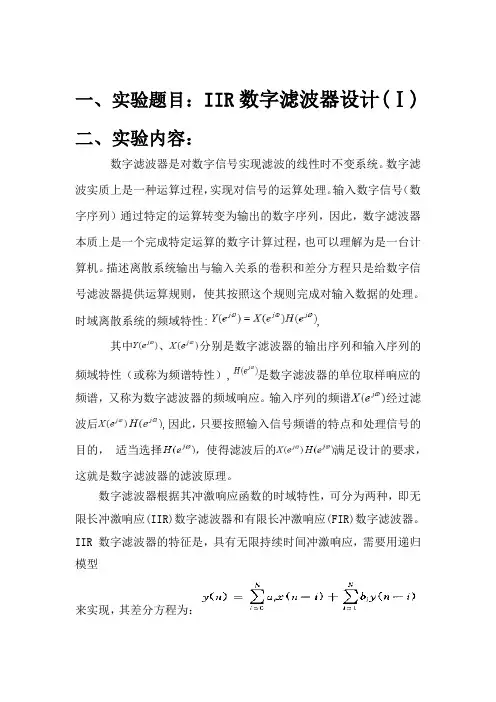
一、实验题目:IIR数字滤波器设计(Ⅰ)二、实验内容:数字滤波器是对数字信号实现滤波的线性时不变系统。
数字滤波实质上是一种运算过程,实现对信号的运算处理。
输入数字信号(数字序列)通过特定的运算转变为输出的数字序列,因此,数字滤波器本质上是一个完成特定运算的数字计算过程,也可以理解为是一台计算机。
描述离散系统输出与输入关系的卷积和差分方程只是给数字信号滤波器提供运算规则,使其按照这个规则完成对输入数据的处理。
时域离散系统的频域特性:,其中、分别是数字滤波器的输出序列和输入序列的频域特性(或称为频谱特性),是数字滤波器的单位取样响应的频谱,又称为数字滤波器的频域响应。
输入序列的频谱经过滤波后,因此,只要按照输入信号频谱的特点和处理信号的目的,适当选择,使得滤波后的满足设计的要求,这就是数字滤波器的滤波原理。
数字滤波器根据其冲激响应函数的时域特性,可分为两种,即无限长冲激响应(IIR)数字滤波器和有限长冲激响应(FIR)数字滤波器。
IIR 数字滤波器的特征是,具有无限持续时间冲激响应,需要用递归模型来实现,其差分方程为:系统函数为:设计IIR滤波器的任务就是寻求一个物理上可实现的系统函数H(z),使其频率响应H(z)满足所希望得到的频域指标,即符合给定的通带截止频率、阻带截止频率、通带衰减系数和阻带衰减系数。
设计一个数字巴特沃斯低通滤波器,设计指标如下:W p=0.2Π, R P=1dBW s=0.3Π, A s=15dB采样时间间隔S。
T1三、实验要求:(1)用单位冲激响应不变变换法进行设计。
(2)给出详细的滤波器设计说明书。
(3)给出经过运行是正确的程序清单并加上详细的注释。
(4)画出所设计滤波器的幅度特性和相位特性。
四.程序与实验说明:1.利用模拟滤波器设计IIR数字滤波器方法(1)根据所给出的数字滤波器性能指标计算出相应的模拟滤波器的设计指标。
(2)根据得出的滤波器性能指标设计出相应的模拟滤波器的系统函数H(S)。
IIR低通滤波器设计
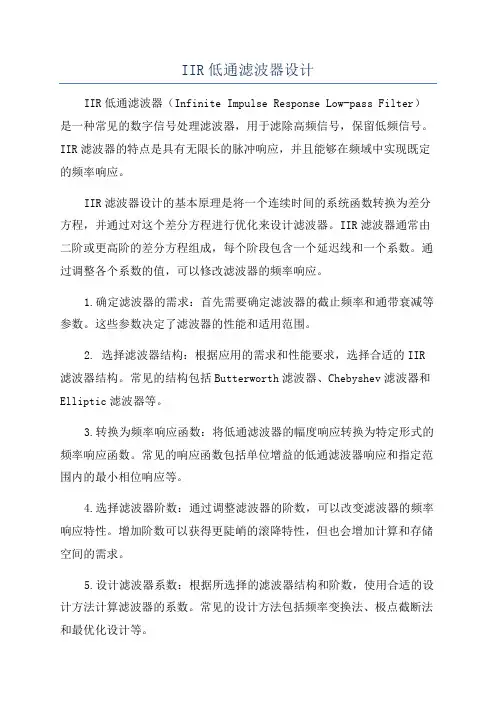
IIR低通滤波器设计IIR低通滤波器(Infinite Impulse Response Low-pass Filter)是一种常见的数字信号处理滤波器,用于滤除高频信号,保留低频信号。
IIR滤波器的特点是具有无限长的脉冲响应,并且能够在频域中实现既定的频率响应。
IIR滤波器设计的基本原理是将一个连续时间的系统函数转换为差分方程,并通过对这个差分方程进行优化来设计滤波器。
IIR滤波器通常由二阶或更高阶的差分方程组成,每个阶段包含一个延迟线和一个系数。
通过调整各个系数的值,可以修改滤波器的频率响应。
1.确定滤波器的需求:首先需要确定滤波器的截止频率和通带衰减等参数。
这些参数决定了滤波器的性能和适用范围。
2. 选择滤波器结构:根据应用的需求和性能要求,选择合适的IIR 滤波器结构。
常见的结构包括Butterworth滤波器、Chebyshev滤波器和Elliptic滤波器等。
3.转换为频率响应函数:将低通滤波器的幅度响应转换为特定形式的频率响应函数。
常见的响应函数包括单位增益的低通滤波器响应和指定范围内的最小相位响应等。
4.选择滤波器阶数:通过调整滤波器的阶数,可以改变滤波器的频率响应特性。
增加阶数可以获得更陡峭的滚降特性,但也会增加计算和存储空间的需求。
5.设计滤波器系数:根据所选择的滤波器结构和阶数,使用合适的设计方法计算滤波器的系数。
常见的设计方法包括频率变换法、极点截断法和最优化设计等。
6. 实现滤波器:将滤波器的差分方程转换为数字信号处理器(DSP)或嵌入式系统中的实际滤波器。
可以使用直接形式、级联形式或者Lattice滤波器结构等不同的实现方式。
7.评估滤波器性能:使用测试数据对设计的滤波器进行评估,并根据需要对滤波器进行调整和优化。
可以使用频率相应曲线、群延迟响应和信号波形等多种方法进行性能评估。
总结来说,设计IIR低通滤波器的过程涉及滤波器需求的确定、结构的选择、频率响应函数的转换、阶数和系数的设定、滤波器实现和性能评估等多个方面。
IIR数字滤波器设计有英文摘要
IIR数字滤波器设计摘要数字滤波器是具有一定传输选择特性的数字信号处理装置,其输入、输出均为数字信号,实质上是一个由有限精度算法实现的线性时不变离散系统。
它的基本工作原理是利用离散系统特性对系统输入信号进行加工和变换,改变输入序列的频谱或信号波形,让有用频率的信号分量通过,抑制无用的信号分量输出。
数字滤波器和模拟滤波器有着相同的滤波概念,根据其频率响应特性可分为低通、高通、带通、带阻等类型,与模拟滤波器相比,数字滤波器除了具有数字信号处理的固有优点外,还有滤波精度高(与系统字长有关)、稳定性好(仅运行在0与l 两个电平状态)、灵活性强等优点。
数字滤波器按单位脉冲响应的性质可分为无限长单位脉冲响应滤波器IIR和有限长单位脉冲响应滤波器(FIR)两种。
本文介绍IIR数字滤波器的设计[4]。
关键词:IIR FIRAbstractDigital filter is a digital filter has the certain transmission choicecharacteristic isdigital signal processing device, signal processing device has the certain transmission choicecharacteristic,Is essentially a realization by the finite precision arithmetic and linear time invariant discrete systems。
Its basic principle is to use the characteristics of discrete system for processing and transformation of system input signal,To change the input sequence spectrum or signal waveform,Let the signal components useful frequency by suppression of signal components, the output of useless。
iir数字滤波器的设计步骤
IIR数字滤波器的设计步骤1.简介I I R(In fi ni te Im pu l se Re sp on se)数字滤波器是一种常用的数字信号处理技术,它的设计步骤可以帮助我们实现对信号的滤波和频率选择。
本文将介绍I IR数字滤波器的设计步骤。
2.设计步骤2.1确定滤波器的类型I I R数字滤波器的类型分为低通滤波器、高通滤波器、带通滤波器和带阻滤波器。
根据信号的要求,我们需确定所需滤波器的类型。
2.2确定滤波器的规格根据滤波器的应用场景和信号特性,我们需确定滤波器的通带范围、阻带范围和衰减要求。
2.3选择滤波器的原型常用的I IR数字滤波器有巴特沃斯滤波器、切比雪夫滤波器和椭圆滤波器等。
根据滤波器的需求,我们需选择适合的滤波器原型。
2.4设计滤波器的传递函数根据滤波器的规格和选定的滤波器原型,我们需计算滤波器的传递函数。
传递函数表示了输入和输出之间的关系,可以帮助我们设计滤波器的频率响应。
2.5对传递函数进行分解将滤波器的传递函数进行分解,可得到II R数字滤波器的差分方程。
通过对差分方程进行相关计算,可以得到滤波器的系数。
2.6滤波器的稳定性判断根据滤波器的差分方程,判断滤波器的稳定性。
稳定性意味着滤波器的输出不会无限增长,确保了滤波器的可靠性和准确性。
2.7选择实现方式根据滤波器的设计需求和实际应用场景,我们需选择I IR数字滤波器的实现方式。
常见的实现方式有直接I I型、级联结构和并行结构等。
2.8优化滤波器性能在设计滤波器后,我们可以对滤波器的性能进行优化。
优化包括滤波器的阶数和抗混淆能力等方面。
3.总结I I R数字滤波器的设计步骤包括确定滤波器的类型和规格、选择滤波器的原型、设计滤波器的传递函数、对传递函数进行分解、判断滤波器的稳定性、选择实现方式和优化滤波器性能等。
通过这些步骤的实施,我们可以有效地设计出满足信号处理需求的II R数字滤波器。
iir数字滤波器的设计
iir数字滤波器的设计什么是iir数字滤波器?iir(infinite impulse response)数字滤波器是一种数字滤波器,与fir(finite impulse response)数字滤波器不同。
与fir数字滤波器只要考虑最近的输入和输出有关,因此具有有限的冲击响应,iir数字滤波器具有无限的冲击响应,因为它们可以让输出与过去的输入有关。
在iir数字滤波器中,有反馈路径,这是与fir数字滤波器不同的。
这意味着,iir滤波器依赖于以前的输出和输入来计算当前的输出。
iir数字滤波器的应用iir数字滤波器在数码信号处理中得到了广泛应用,可以用于各种应用,包括:•音频处理:包括音频滤波器,均衡器和调音台等•通信:数字化通信和语音处理•生产控制:包括传感器计算和控制器如何设计iir数字滤波器?要设计iir数字滤波器,我们需要考虑几个步骤。
1. 确定数字滤波器的类型在设计iir数字滤波器之前,我们需要先确定所需的数字滤波器类型。
通常,数字滤波器可以分为以下两类:•低通滤波器(LPF)•高通滤波器(HPF)根据所需的应用程序和系统需求,您可以确定所需的滤波器类型。
2. 确定滤波器规格在设计iir数字滤波器之前,我们需要确定所需的滤波器规格。
这包括通带和阻带频率,通带和阻带增益等。
3. 选择设计工具在选择设计工具时,可以使用以下工具:•Matlab•Python4. 根据设计规格进行设计使用所选的设计工具,我们可以根据滤波器规格进行设计。
例如,我们可以使用Matlab中的dsp工具箱设计数字滤波器。
Fs = 1000; % 采样频率Fpass = 200; % 通带频率Fstop = 300; % 阻带频率Apass = 1; % 通带最大衰减Astop = 80; % 阻带最小衰减% 将数字滤波器设计为低通滤波器,并使用butterworth滤波器设计方法d = fdesign.lowpass('Fp,Fst,Ap,Ast',Fpass,Fstop,Apass,Astop,Fs);Hd = design(d,'butter');% 将数字滤波器设计为高通滤波器,并使用chebyshev滤波器设计方法d = fdesign.highpass('Fst,Fp,Ast,Ap',Fpass,Fstop,Astop,Apass,Fs);Hd = design(d,'cheby1');以上示例演示了如何使用Matlab中的dsp工具箱设计数字低通滤波器和数字高通滤波器。
IIR滤波器 翻译
and stopband,respectively,the error at the passband and stopband
can be controlled. Finally, we show some examples to validate the
proposed method.
这个方法是有效的,因为有
不需要任何初始值或复合优化算法通过
该方法中,准等波纹溶液非常快速地得到
具有较少的计算复杂性。此外,通过乘以一个
在通带的所需反应arbitrary加权函数
和阻带,分别在通带和阻带误差
可被控制。最终,我们表明一些例子来验证
提出的方法,
no need for any initial value or complex optimization algorithm . By
this method, a quasi-equiripple solution is obtained very quickly
with less computational complexity. Moreover, by multiplying an
to have equiripple error.
摘要:在本文中,我们提出无限冲激响应(IIR)数字滤波器与复数域准等纹波绝对误差一种新的设计方法。此方法是基于求解最小二乘解迭代。在每次迭代中,对于最小二乘逼近期望的反应转化
有等波纹错误。
This algorithm is efficient because there is
Design of IIR Digital Filters in the Complex Domain
- 1、下载文档前请自行甄别文档内容的完整性,平台不提供额外的编辑、内容补充、找答案等附加服务。
- 2、"仅部分预览"的文档,不可在线预览部分如存在完整性等问题,可反馈申请退款(可完整预览的文档不适用该条件!)。
- 3、如文档侵犯您的权益,请联系客服反馈,我们会尽快为您处理(人工客服工作时间:9:00-18:30)。
IIR
Digita
Filter
Dห้องสมุดไป่ตู้sign
An important step in the development of a digital filter is the determination of a realizable transfer function G(z) approximating the given frequency response specifications. If an IIR filter is desired,it is also necessary to ensure that G(z) is stable. The process of deriving the transfer function G(z) is called digital filter design. After G(z) has been obtained, the next step is to realize it in the form of a suitable filter structure. In chapter 8,we outlined a variety of basic structures for the realization of FIR and IIR transfer functions. In this chapter,we consider the IIR digital filter design problem. The design of FIR digital filters is treated in chapter 10.
9.1.1Digital Filter Specifications
As in the case of the analog filter,either the magnitude and/or the phase(delay) response is specified for the design of a digital filter for most applications. In some situations, the unit sample response or step response may be specified. In most practical applications, the problem of interest is the development of a realizable approximation to a given magnitude response specification. As indicated in section4.6.3, the phase response of the designed filter can be corrected by cascading it withan allpass section. The design of allpass phase equalizers has received a fair amount of attention in the last few years.
9.1 preliminary considerations
There are two major issues that need to be answered before one can develop the digital transfer function G(z). The first and foremost issue is the development of a reasonable filter frequency response specification from the requirements of the overall system in which the digital filter is to be employed. The second issue is to determine whether an FIR or IIR digital filter is to be designed. In the section ,we examine these two issues first . Next we review the basic analytical approach to the design of IIR digital filters and then consider the determination of the filter order that meets the prescribed specifications. We also discuss appropriate scaling of the transfer function.
